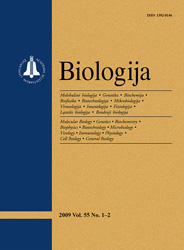Biologija / Biology
 ISSN 1392-0146 ISSN 2029-0578 (online) |
2006 m. Nr. 4 Time of response to different simple stimuli in
45–90-year-old persons
The aim of the current work was to investigate the rate of response to colour light (red, green and motley), sound stimuli and the catching of a free-falling line (stick) in younger and older adults (male and female) who considered themselves healthy, with the purpose of assessing the impact of aging on performing different types of simple tasks. Two hundred thirty four (234) people who considered themselves healthy (76 men, 158 women) participated in the study. The sample was divided according to age: group I – 45–59 years (42 persons), group II – 60–74 years (114 persons), group III – 75–89 years (72 persons), group IV – 90 years (6 persons). Response time (RT) measurements were performed employing two devices: a standard chronoreflexometer and a RTM-802 time monitor (Nelson reaction timer). The study has shown that RT response to different simple stimuli was directly dependent on age. It was significantly slower (p < 0.01) in the age groups of 75–89 years than in the middle-aged groups. The gender differences in RT were pronounced (p < 0.01) only to sound stimulus in the group aged 75–89 years. A comparative analysis of response time to a colour stimulus showed that in all age groups (except females from group IV) it was shortest to green light and longest to motley light, the red light stimulus taking an intermediate position. The RT to a falling line in 66.7% of the cohort increased more slowly (and even at the age of 90 it was £ 295 ms) and in 33.3% more rapidly (and in the old age already exceed 295 ms). Data of our study have shown that age-related delay in RT arises from a delay in peripheral sensorimotor processes. Our data corroborated the hypothesis about the deceleration of peripheral processes in the elderly. Differences in age-related decline in RT to different simple stimuli indicate a range of additional slowing in the elderly as regards different types of stimulation. This knowledge is of importance for planning intervention and physiological procedures.
Keywords: response time, elderly, stimuli |
Issues:
2011 - Vol.57 No. 1, No. 2, No. 3 2010 - Vol.56 No. 1-4 2009 - Vol.55 No. 1-2, No. 3-4 2008 - Vol.54 No. 1, No. 2, No. 3, No. 4 2007 - Vol.53 No. 1, No. 2, No. 3, No. 4 2006 No. 1, No. 2, No. 3, No. 4 2005 No. 1, No. 2, No. 3, No. 4 2004 No. 1, No. 2, No. 3, No. 4 2003 No. 1, No. 2, No. 3, No. 4 2002 No. 1, No. 2, No. 3, No. 4 2001 No. 1, No. 2, No. 3, No. 4 |